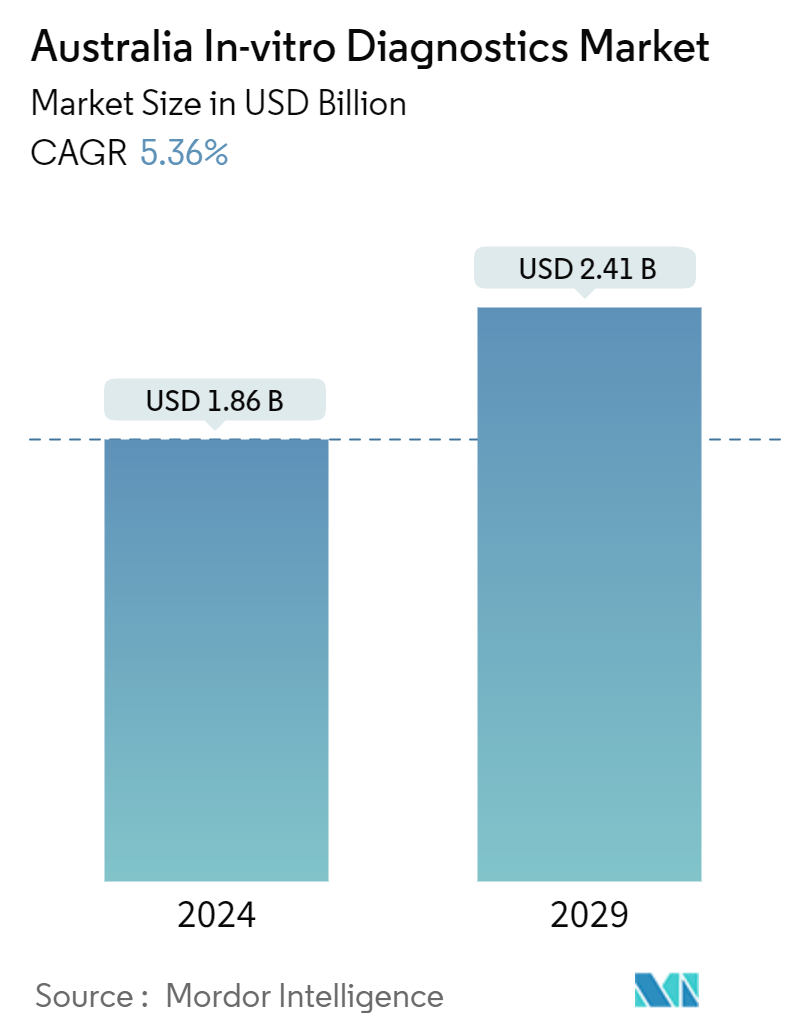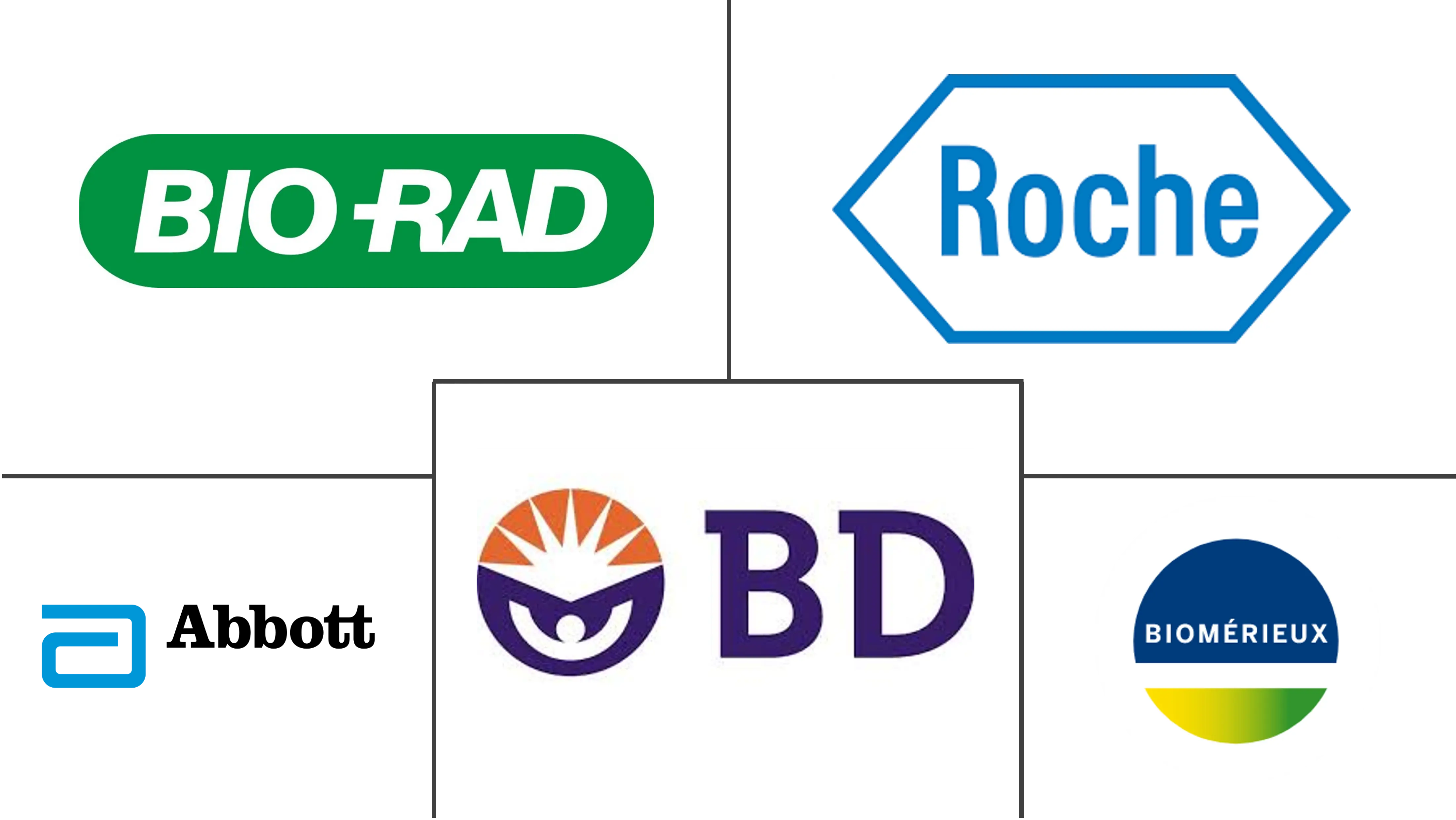Market Size of Australia In-vitro Diagnostics Industry

| Study Period | 2019 - 2029 |
| Base Year For Estimation | 2023 |
| Forecast Data Period | 2024 - 2029 |
| Market Size (2024) | USD 1.86 Billion |
| Market Size (2029) | USD 2.41 Billion |
| CAGR (2024 - 2029) | 5.36 % |
Major Players
*Disclaimer: Major Players sorted in no particular order |
Australia In Vitro Diagnostics Market Analysis
The Australia In-vitro Diagnostics Market size is estimated at USD 1.86 billion in 2024, and is expected to reach USD 2.41 billion by 2029, growing at a CAGR of 5.36% during the forecast period (2024-2029).
COVID-19 had an unprecedented impact on the growth of the market over the pandemic period. The sudden outbreak of the pandemic, which increased the demand for in vitro diagnostics, alerted the Australian government to meet the needs of the population. For instance, a November 2022 TGA article reported that the Therapeutic Goods Administration (TGA) is working with IVD suppliers to ensure tests are available to help manage the COVID-19 pandemic. The article also mentioned that the TGA prioritized COVID-19 tests, including rapid antigen tests throughout 2022, and focused on tests that detect both the influenza virus and COVID-19. Such developments and the prioritization of COVID-19 testing by the government of Australia had a notable impact on the growth of the market during the pandemic. In addition, the demand for in-vitro diagnostics is expected to remain intact due to the emergence of mutant strains of the SARS-CoV-2 virus during the post-pandemic period, thereby contributing to the growth of the market during the forecast period.
The major factors for the growth of the market in Australia are the high prevalence of chronic diseases, the increasing usage of point-of-care diagnostics, and the high adoption of advanced technologies. Additionally, the presence of major market players and favorable government policies are also expected to contribute to the growth of the market over the forecast period.
For instance, according to the Australian Bureau of Statistics, whose data was updated in March 2022, during the years 2020-2021, 78.6% of Australians, or 11.6 million people, had at least one long-term health condition, and 46.6 percent, or 11.6 million people, had at least one chronic condition. One or more chronic illnesses affected nearly half of Australians of all ages (46.6%), and nearly one in five (18.6%) had two or more. One in five females (20.7%) and over half (49.0%) of all females had two or more chronic illnesses. Likewise, 16.4% of men had two or more chronic diseases, and 43.9 percent of men had one or more. Also, according to the 2022 statistics published by the Australian Institute of Health and Welfare, an estimated 571,000 Australians aged 18 and over had chronic heart diseases in 2021. The prevalence of various illnesses among the Australian population is expected to drive demand for effective in vitro diagnostics, contributing to market growth over the forecast period.
Furthermore, increased product development and product approvals are expected to drive market growth. For instance, in August 2021, SpeeDx Pty., Ltd. received clearance from the Australian Therapeutic Goods Administration for the PlexPCR SARS-CoV-2 test. The test is ideally suited to support rapid response to handling robotics in the form of SpeeDx PlexPrep. However, stringent regulations in Australia are expected to impede the growth of the market over the forecast period.
Australia In Vitro Diagnostics Industry Segmentation
As per the scope of this report, in-vitro diagnostics involves medical devices and consumables that are utilized to perform in-vitro tests on various biological samples. They are used for the diagnosis of various medical conditions and chronic diseases. The in-vitro diagnostics market in Australia is classified by test type (clinical chemistry, molecular diagnostics, immunodiagnostics, hematology, and other test types), product type (instruments, reagents, and other types of products), application (infectious disease, diabetes, cancer/oncology, cardiology, autoimmunity, and other applications), and end user (diagnostic laboratories, hospitals, and clinics, and other end users). The report offers the value (in USD million) for the above segments.
| By Test Type | |
| Clinical Chemistry | |
| Molecular Diagnostics | |
| Immuno Diagnostics | |
| Haematology | |
| Other Test Types |
| By Type of Product | |
| Instruments | |
| Reagents | |
| Other Types of Product |
| By Application | |
| Infectious Disease | |
| Diabetes | |
| Cancer/Oncology | |
| Cardiology | |
| Autoimmune Disease | |
| Other Applications |
| By End User | |
| Diagnostic Laboratories | |
| Hospitals and Clinics | |
| Other End Users |
Australia In-vitro Diagnostics Market Size Summary
The Australian in vitro diagnostics market is poised for steady growth, driven by several key factors. The market experienced a significant boost during the COVID-19 pandemic, as the demand for diagnostic tests surged, prompting government intervention to ensure test availability. This trend is expected to continue due to the emergence of new SARS-CoV-2 variants. The market's expansion is further supported by the high prevalence of chronic diseases, increased use of point-of-care diagnostics, and the adoption of advanced technologies. The presence of major industry players and supportive government policies also contribute to the market's positive outlook. However, stringent regulatory requirements may pose challenges to market growth.
The demand for molecular diagnostics is rising, fueled by the increasing incidence of chronic and infectious diseases in Australia. The market is characterized by frequent product approvals and advancements in research and development, which are expected to drive growth. The infectious diseases segment is anticipated to hold a significant market share, supported by the high prevalence of sexually transmitted infections and the need for effective diagnostics. Strategic partnerships and collaborations among market players, along with favorable government initiatives, are likely to further enhance market growth. The competitive landscape is dominated by major players such as BioMerieux, Hoffmann-La Roche Ltd., and Abbott, among others, who continue to influence the market dynamics through innovative product offerings and strategic collaborations.
Australia In-vitro Diagnostics Market Size - Table of Contents
-
1. MARKET DYNAMICS
-
1.1 Market Overview
-
1.2 Market Drivers
-
1.2.1 High Prevalence of Chronic Diseases
-
1.2.2 Increasing Use of Point-of-care (POC) Diagnostics
-
1.2.3 Advanced Technologies
-
-
1.3 Market Restraints
-
1.3.1 Stringent Regulations
-
-
1.4 Porter's Five Forces Analysis
-
1.4.1 Threat of New Entrants
-
1.4.2 Bargaining Power of Buyers/Consumers
-
1.4.3 Bargaining Power of Suppliers
-
1.4.4 Threat of Substitute Products
-
1.4.5 Intensity of Competitive Rivalry
-
-
-
2. MARKET SEGMENTATION
-
2.1 By Test Type
-
2.1.1 Clinical Chemistry
-
2.1.2 Molecular Diagnostics
-
2.1.3 Immuno Diagnostics
-
2.1.4 Haematology
-
2.1.5 Other Test Types
-
-
2.2 By Type of Product
-
2.2.1 Instruments
-
2.2.2 Reagents
-
2.2.3 Other Types of Product
-
-
2.3 By Application
-
2.3.1 Infectious Disease
-
2.3.2 Diabetes
-
2.3.3 Cancer/Oncology
-
2.3.4 Cardiology
-
2.3.5 Autoimmune Disease
-
2.3.6 Other Applications
-
-
2.4 By End User
-
2.4.1 Diagnostic Laboratories
-
2.4.2 Hospitals and Clinics
-
2.4.3 Other End Users
-
-
Australia In-vitro Diagnostics Market Size FAQs
How big is the Australia In-vitro Diagnostics Market?
The Australia In-vitro Diagnostics Market size is expected to reach USD 1.86 billion in 2024 and grow at a CAGR of 5.36% to reach USD 2.41 billion by 2029.
What is the current Australia In-vitro Diagnostics Market size?
In 2024, the Australia In-vitro Diagnostics Market size is expected to reach USD 1.86 billion.

